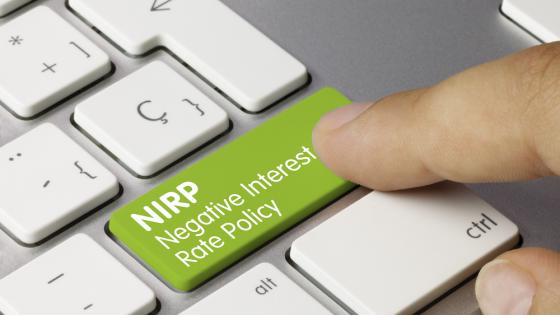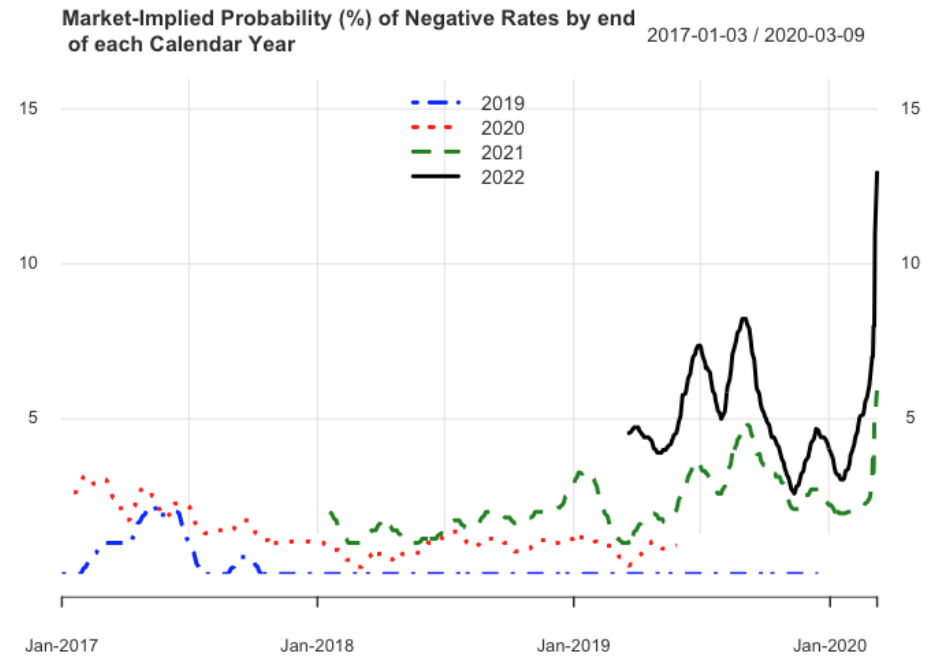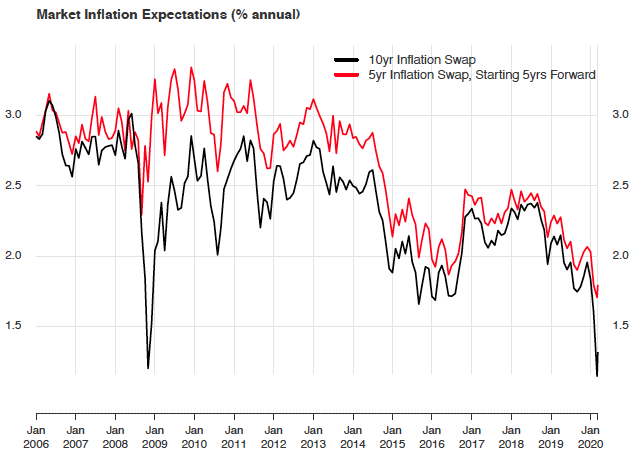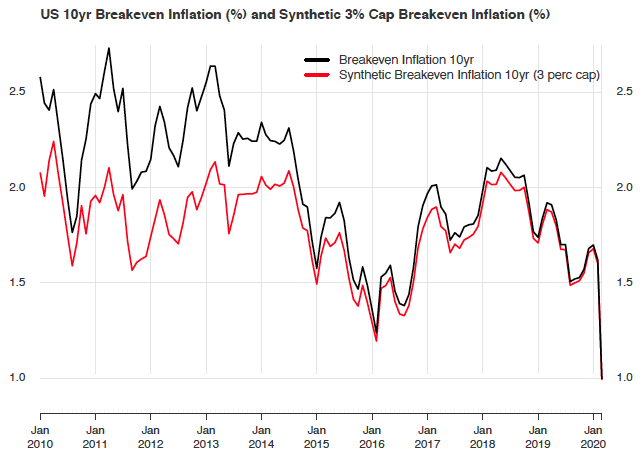Combatting the Covid-19 health catastrophe, governments have rightly responded with extremely aggressive fiscal policy. Central banks have also taken extraordinary measures propping up private credit markets as well as weaker sub-sovereigns (weaker countries in the case of the ECB). But what will become of ordinary monetary policy once the most intense phases of the pandemic have passed, and the global economy of the 2020s settles into the ‘new-new’ normal? In particular, do we really want to revert to a perma-zero-bound state where the main tool of monetary policy, i.e. the overnight interest rate, is shut down most of the time?
In Lilley and Rogoff (2019), as well as Rogoff (2015, 2016, 2017), we have argued that in a low inflation rate world, central banks need scope for being able to set significantly negative interest rates in deep recessions and crises. Importantly, in most countries this is not something central banks can do on their own. Effective negative interest rate policy requires legal, tax and regulatory changes that typically require cooperation from the government.
By far the biggest obstacle is to forestall wholesale cash hoarding, though there are relatively straightforward mechanisms for achieving this which are minor compared to other changes taking place at the moment. These do not require eliminating cash, although it is certainly becoming politically easier over time as cash is marginalized in legal, tax-compliant transactions. Although it is much too soon to judge, it is certainly plausible that Covid-19 will lead to a sharp reduction of cash use even in the last bastion of small transactions.
It is not difficult to exempt the overwhelming majority of retail depositors from negative rate policy. The issue of passthrough from banks to large depositors – which is proving less and less of an issue over time anyway – should completely disappear once the cash hoarding option is taken off the table (Rogoff 2016, Bordo and Lilley 2019). There is of course, an extensive empirical literature on the early experience with negative rates in Europe and Japan, which we survey in Lilley and Rogoff (2019) but do not have space here to detail. Importantly, the evidence over time seems to be tipping towards the view that negative rate policy has had a positive impact (e.g. Altavilla et al. 2019, Bottero et al. 2019). However, most importantly, no country yet has taken the simple but necessary steps to prevent wholesale cash hoarding by financial firms, insurance companies, and pension funds, necessary for ‘whatever it takes’ deep negative rate policy to be effective.
Hasn’t the heroic central bank response to the recent pandemic shown that interest rate policy is no longer needed? Hardly. In a crisis, central banks play an essential role of market makers of last resort, but routine intervention into private markets in a large complex economy is an extremely clumsy tool that, if used on routine basis, would ultimately undermine central bank independence.
Interestingly, even in the US, where there is no framework yet for negative interest rates, markets attach a substantial probability to their adoption. As shown in figure 1, markets now assign 13% probability to Libor borrowing rates being materially below zero within the next three years, implying a federal funds rate which is even lower. (See Lilley and Rogoff 2019 for details of the calculation.)
Figure 1 Market implied probabilities of negative interest rates by end of each calendar year
Note: Market-implied probabilities of three-month LIBOR (USD) rates setting below −0.25 percent at December 15 of 2018 through 2021. Market-implied probabilities are derived from options prices on the Eurodollar futures with strikes of 100.25 and 100.5, which correspond to LIBOR rates of −25 bps and −50 bps, respectively. Probabilities are lower bounds and are estimated assuming risk neutrality, averaged over the preceding month. Eurodollar option price data from Bloomberg. See Lilley and Rogoff (2020) for details.
This is hardly surprising, given that market now see the Fed Fund rates as stuck at zero several years into the future, as the figure 2 indicates.
Figure 2 Length of time financial markets expect the fed funds rate to be constrained at zero
Note: Figure plots the length of time the market expected the Fed Funds Rate to be constrained at zero, in years. Calculation is derived from the prices of futures on the federal funds rate. Data is from Bloomberg.
Indeed, it is now clear that the market no longer believes that the Fed has the tools to keep inflation at its 2% target. Ten year inflation swaps (a derivative on the future value of the consumer price index) show that the market expects CPI inflation to average 1.3% over the next decade.1 More concerning is the expectation of the five year inflation rate beginning five years from now, which averages 1.8%. This second fact suggests that the market’s change in beliefs has moved beyond the present crisis, and it now has re-evaluated the extent to which it expects the Fed to be constrained more generally. One problem with such a scenario is that it poses a perverse feedback loop. As the Fed becomes more constrained by the zero lower bound, the expected inflation rate falls, lowering the neutral nominal interest rate, which in turn makes the zero lower bound more binding.
Figure 3 Expectations of inflation from market instruments
Note: Figure plots the zero coupon inflation swap rate for various maturities. The blue line shows the ten year inflation swap rate. The gray line shows the five year forward five year inflation swap rate. Data is from Bloomberg.
Markets rightly realize that the Fed’s quasi fiscal instruments may be a good temporary substitute for Treasury action (and the Treasury will have to absorb the cost of any eventual losses) but are not effective instruments for raising inflation. Interestingly, as we demonstrate in Lilley and Rogoff (2019), part of the impact on inflation expectations of Federal Reserve actions in the years following the 2008 financial crisis (particularly QE II and QE III) came not so much through higher median inflation expectations, but by causing a spike in the expectation of very high inflation (see figure 4).
Figure 4 US 10-year breakeven inflation (%) and synthetic 3% cap breakeven inflation (%)
Notes: Breakeven Inflation 10 year is calculated using the difference in yields of real and nominal Treasury bonds for the United States, with adjustments to estimate their yields for a constant maturity and without coupons, using bond yield data from Gürkaynak et al. (2007, 2010). The synthetic ten-year breakeven with a 3 percent cap is the implied breakeven on an inflation-linked bond that pays the inflation rate capped at 3 percent per annum, calculated using the market pricing of inflation swaption caps. Further detail on the pricing of the synthetic inflation–linked bond is provided in Lilley and Rogoff (2019).
Markets no longer believe that QE in the US can bring expected inflation to target, much less create very high inflation. Of course, markets learned this long ago in the case of Japan, where long-term inflation expectations have been stuck below half a percent through very aggressive QE programs and even, one might argue, de facto helicopter money.
Given the steady downward drift in global real interest rates, the difficulties in raising expected inflation, the ineffectiveness of quasi-fiscal instruments at the zero bound, and ultimately the importance to central bank independence of having an instrument of unilateral control, create a strong imperative for proactively preparing now for a negative interest rate world that is perhaps inevitable. As we move towards a world that may require massive investments to restructure the economy and where many businesses may need to borrow for an extended period just to stay afloat, negative nominal rates may well be the lesser evil.
Of course, it is entirely possible that at the end of this dizzying, but necessary fiscal binge, real interest rates may end up significantly higher than market now expect, and so too might inflation. But there is at least a good chance central banks will be stuck at the zero effective lower bound for a very long time.
We weren’t prepared for the pandemic, but we can be prepared for what follows.
References
Altavilla, C, L Burlon, M Giannetti and S Holton (2019), “Is There a Zero Lower Bound? The Effects of Negative Policy Rates on Banks and Firms”, ECB working paper, updated October 2019.
Bordo, M D, and A T Levin (2019), “Digital Cash: Principles and Practical Steps”, National Bureau of Economic Research Working Paper 24555, January 2019.
Bottero, M, C Minoiu, J Peydro, A Polo, A F Presbitero and E Sette (2019), “Negative Policy Rates and Portfolio Rebalancing: Evidence from Credit Register Data”, IMF working paper WP/19/44, February.
Lilley, A, and K Rogoff (2019), “The Case for Implementing Effective Negative Interest Rate Policy”, Strategies for Monetary Policy, (Stanford: Hoover Institution Press),
Rogoff, K (2016), The Curse of Cash, Princeton, Princeton University Press.
Rogoff, K (2015), “Costs and Benefits to Phasing Out Paper Currency”, NBER Macroeconomics Annual 2014, Vol. 29: 445-456. Macro Annual
Rogoff, K (2017), “Dealing with Monetary Paralysis at the Zero Bound”, Journal of Economic Perspectives 31 (3): 47-66.
Endnotes
1 We use zero coupon inflation swaps rather than the Breakeven Inflation spread on Treasuries, since the Breakeven yield on treasuries may be artificially depressed by temporary illiquidity of real bonds during market stress episodes (D’Amico et. al, 2018).







